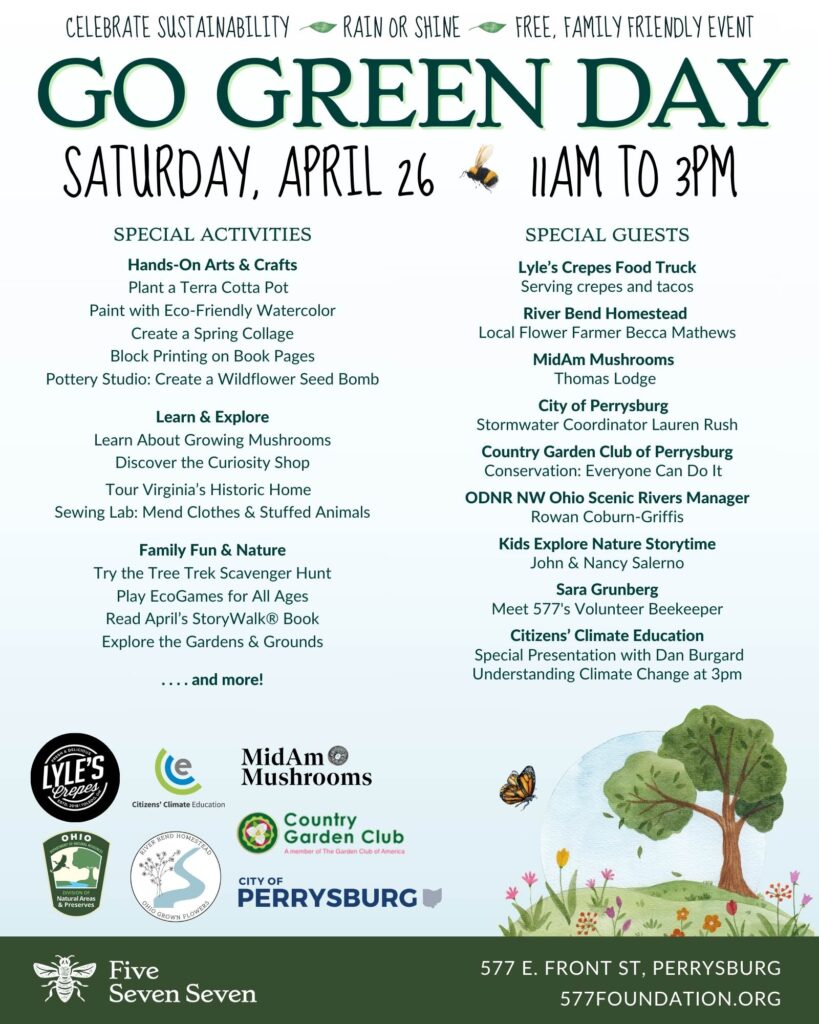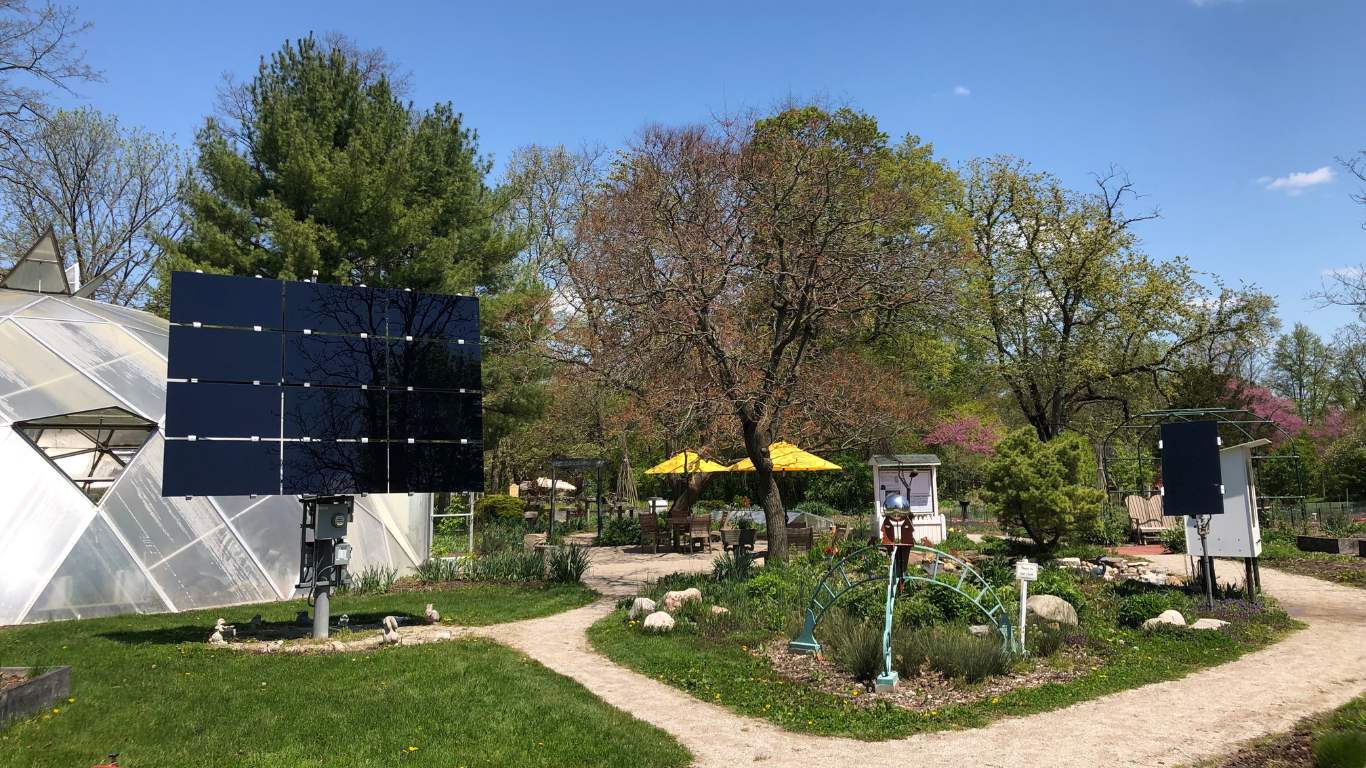Every Day is Earth Day at 557: Behind the Scenes of Our Sustainability Efforts
At 577, sustainability isn’t just a talking point, it’s woven into the fabric of everything we do. Inspired by founder Virginia Secor Stranahan’s vision to “keep a corner of Perrysburg green,” our team continues to care for the land, conserve resources, and serve as a model for environmental stewardship.
As Earth Day (April 22) approaches, we invite you to take a look behind the scenes at how we care for this special place and offer a few ideas for how you can do the same at home.
A Legacy of Preservation
In 1987, a conservation easement was established with The Nature Conservancy to legally protect the land that Virginia Secor Stranahan held so dear. This agreement ensured that the property would be preserved in its natural state, preventing future development and safeguarding open green space for generations to come. In 1993, the easement was transferred to Black Swamp Conservancy, a local land trust founded in 1989 by Virginia and other area conservationists who shared her commitment to preserving natural spaces. Her vision was clear: to keep a corner of Perrysburg green and to give people meaningful access to the Maumee River. That same vision continues to guide our work today, nearly four decades later, as we uphold her legacy through daily stewardship of the land and a deep commitment to environmental education and conservation.
Thoughtful Landscape Design
The gardens and natural spaces at 577 are more than beautiful, they’re intentional. Managed by our Properties team, every element of the landscape supports ecological health:
- Rain Gardens: These planted areas manage stormwater naturally, filtering runoff and creating habitat for native species.
- Water-Permeable Paths: Instead of contributing to runoff, these walkways allow rain to soak into the ground.
- Onsite Composting & Leaf Mulch: Enriching the soil and reducing waste from gardens and grounds.
- Natural Brush & Habitat Walls: Repurposed materials like invasive buckthorn and fallen limbs become shelter for birds, insects, and other wildlife.
In 2022, we also completed a sewer separation project with the City of Perrysburg to ensure that clean rainwater goes directly to the river, not the treatment plant. This is an important step in protecting local waterways.
Organic Gardening & Community Engagement
Our organic gardens, including 60 active community plots, are grown without synthetic chemicals. Staff and volunteers compost garden waste, save seeds, and donate fresh produce to local food access programs like SAME Café and Perrysburg Christians United Food Bank. It’s all part of building a resilient, connected community.
Samantha and Bennett, our horticulture staff, also teach monthly classes on topics like sustainable gardening, seed saving, and native plant landscaping. Community instructors are encouraged to support conservation values, including reusing materials, avoiding single-use plastics, and promoting creativity with sustainability in mind.
Sustainable Forestry & Pollinator Support
From “No Mow May” to butterfly rearing and bee hives, we work to foster a thriving ecosystem. Each spring and summer, visitors can observe the magic of transformation in our Flutter Hut as caterpillars become butterflies. Around the property, shallow bat houses, native flowering plants, and beehives offer food and shelter for important pollinators.
Our team actively removes invasive plants like honeysuckle and buckthorn and replaces them with native species that support biodiversity. Trees like redbud and hazelnut, and plants like coneflower and goldenrod, provide essential habitat for local wildlife.
Energy Conservation in Action
Across the grounds, our buildings and systems are designed with energy efficiency in mind:
- LED Lighting in all buildings and outdoor areas
- HVAC setback systems that automatically adjust when buildings aren’t in use
- Solar Thermal Panels that heat water in the Welcome Center, Pottery Barn, and Courtyard bathroom
- Photovoltaic Solar Tracker, installed in 2016, powers fans and pumps inside the Geodesic Biodome
- Passive Solar Heating, using black water barrels in the dome and greenhouse to store and radiate heat
These technologies help us reduce our energy footprint while modeling real-world solutions for our visitors.
Reduce, Reuse, Recycle—Every Day
We prioritize purchasing eco-certified paper products and bio-based cleaning supplies, like our Sunflower Fresh hand soap and glass cleaner. Outdoor benches and tables are made from recycled poly lumber, and paint palettes used in art classes were repurposed from older grounds equipment.
One of the most visible ways we promote reuse is through the Welcome Center & Curiosity Shop. Thanks to early grant support, this space has become a hub for gently used books, art supplies, and pottery—diverting materials from the landfill and making creative tools more affordable and accessible to all.
As Executive Director Heather Gallant shared, “The Curiosity Shop is a place where people can feel good about regifting their art supplies and books to others, at a place that promotes conservation and sustainable environmental practices in Northwest Ohio.”
Take It Home: How You Can Help
Looking to make a difference at home? Here are a few ways to start:
- Switch to LED bulbs and unplug unused electronics
- Plant native species and skip the pesticides
- Compost kitchen scraps and use natural mulch in your garden
- Shop secondhand and donate gently used items
- Skip mowing for a week or two in May to help early pollinators thrive
Each small change adds up, and when we work together, we can build a more sustainable future for generations to come.
We invite you to join us for Go Green Day on Saturday, April 26, from 11am to 3pm—a free, family-friendly event celebrating sustainability with hands-on activities, garden exploration, and creative ways to care for the earth. Come be inspired, connect with others, and discover how you can make a difference in your own backyard.




